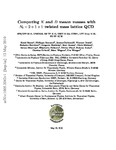Computing K and D meson masses with twisted mass lattice QCD
| dc.contributor.author | Baron, R | |
| dc.contributor.author | Boucaud, P | |
| dc.contributor.author | Carbonell, J | |
| dc.contributor.author | Drach, V | |
| dc.contributor.author | Farchioni, F | |
| dc.contributor.author | Herdoiza, G | |
| dc.contributor.author | Jansen, K | |
| dc.contributor.author | Michael, C | |
| dc.contributor.author | Montvay, I | |
| dc.contributor.author | Pallante, E | |
| dc.contributor.author | Pène, O | |
| dc.contributor.author | Reker, S | |
| dc.contributor.author | Urbach, C | |
| dc.contributor.author | Wagner, M | |
| dc.contributor.author | Wenger, U | |
| dc.date.accessioned | 2018-07-25T15:26:15Z | |
| dc.date.available | 2018-07-25T15:26:15Z | |
| dc.date.issued | 2011-02 | |
| dc.identifier.issn | 0010-4655 | |
| dc.identifier.issn | 1879-2944 | |
| dc.identifier.uri | http://hdl.handle.net/10026.1/11912 | |
| dc.description | 30 pages, 10 figures | |
| dc.description.abstract |
We discuss the computation of the mass of the K and D mesons within the framework of Nf=2+1+1 twisted mass lattice QCD from a technical point of view. These quantities are essential, already at the level of generating gauge configurations, being obvious candidates to tune the strange and charm quark masses to their physical values. In particular, we address the problems related to the twisted mass flavor and parity symmetry breaking, which arise when considering a non-degenerate (c,s) doublet. We propose and verify the consistency of three methods to extract the K and D meson masses in this framework. © 2010 Elsevier B.V. All rights reserved. | |
| dc.format.extent | 299-316 | |
| dc.language | en | |
| dc.language.iso | en | |
| dc.publisher | Elsevier BV | |
| dc.subject | Lattice QCD | |
| dc.subject | Twisted mass | |
| dc.subject | 2+1+1 dynamical quark flavors | |
| dc.title | Computing K and D meson masses with twisted mass lattice QCD | |
| dc.type | journal-article | |
| dc.type | Journal Article | |
| plymouth.author-url | https://www.webofscience.com/api/gateway?GWVersion=2&SrcApp=PARTNER_APP&SrcAuth=LinksAMR&KeyUT=WOS:000285661600003&DestLinkType=FullRecord&DestApp=ALL_WOS&UsrCustomerID=11bb513d99f797142bcfeffcc58ea008 | |
| plymouth.issue | 2 | |
| plymouth.volume | 182 | |
| plymouth.publisher-url | http://dx.doi.org/10.1016/j.cpc.2010.10.004 | |
| plymouth.publication-status | Published | |
| plymouth.journal | Computer Physics Communications | |
| dc.identifier.doi | 10.1016/j.cpc.2010.10.004 | |
| plymouth.organisational-group | /Plymouth | |
| plymouth.organisational-group | /Plymouth/Faculty of Science and Engineering | |
| plymouth.organisational-group | /Plymouth/Faculty of Science and Engineering/School of Engineering, Computing and Mathematics | |
| plymouth.organisational-group | /Plymouth/REF 2021 Researchers by UoA | |
| plymouth.organisational-group | /Plymouth/REF 2021 Researchers by UoA/EXTENDED UoA 10 - Mathematical Sciences | |
| plymouth.organisational-group | /Plymouth/REF 2021 Researchers by UoA/UoA10 Mathematical Sciences | |
| plymouth.organisational-group | /Plymouth/Users by role | |
| plymouth.organisational-group | /Plymouth/Users by role/Academics | |
| dc.identifier.eissn | 1879-2944 | |
| dc.rights.embargoperiod | No embargo | |
| rioxxterms.versionofrecord | 10.1016/j.cpc.2010.10.004 | |
| rioxxterms.licenseref.uri | http://www.rioxx.net/licenses/all-rights-reserved | |
| rioxxterms.type | Journal Article/Review |


